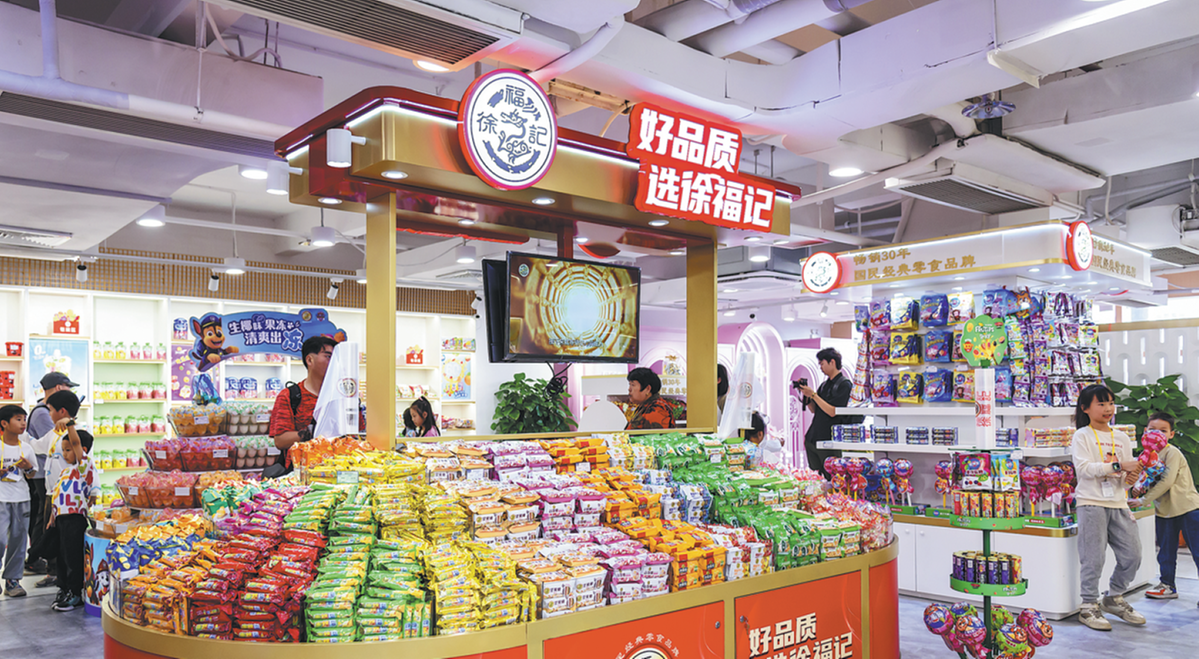Candy play Hsu Fu Chi seeking sweet success story overseas
China Daily, August 26, 2024 Adjust font size:

Hsu Fu Chi, a leading manufacturer of confectionery products in China, recently launched its candy buckets at Costco, the largest chain membership warehouse store in the United States.
This move not only marks Hsu Fu Chi's entry into the North American market, but also underscores its firm steps on the path to globalization. The company's online products have also made their way to North American shopping websites such as Weee! — the top online Asian supermarket in the US — and Yami Buy, another shopping website targeting Asian Americans, as well as supermarkets under Walmart, Sobeys and Loblaws Group in Canada.
Hsu Fu Chi's going-global efforts started in Southeast Asia. By 2023, its products had begun to cover local chain supermarkets like Lotus's and Aeon in Malaysia. Its candy products have become very popular in Vietnam, achieving significant growth in Southeast Asia.
In 2018, Three Squirrels, a top nut snack producer in Anhui province, began its overseas market layout. Currently, over 100 stock keeping units have entered markets such as the United States, Malaysia, Thailand and Singapore. Brand flagship stores have also been established on mainstream cross-border e-commerce platforms like Lazada, Amazon and JD.
"For overseas food and beverage companies, the populous Chinese market is the world's largest fast-moving consumer goods market. But for Chinese food and beverage brands, the massive overseas market is also full of opportunities," said Mei Hongdao, director of the overseas development division of Want Want Group, a leading snack producer in China.
According to industry data, global snack sales are likely to have reached $507.2 billion in 2023, and it is expected that the market will reach $835.8 billion by the end of 2033. The global snack market is expected to grow at a compound annual growth rate of 5.1 percent over the next decade.
Many domestic F&B companies choose to launch their global journeys from Southeast Asia. The Southeast Asian market, mainly concentrated in countries such as Thailand, Malaysia, Singapore and Vietnam, has a total population of about 600 million.
Maria Yang, director of food, beverage, and health category at Lazada China, which operates one of the largest online shopping websites in Southeast Asia, said this market is characterized by a young average age of consumers — just 29 years old — indicating hope and vitality.
Additionally, the overall market size is relatively large, with data showing that by 2023, the combined online and offline retail scale in Southeast Asia could have reached $4 trillion. These countries also have relatively healthy economies and a substantial overseas Chinese population.
At present, Southeast Asian e-commerce has vast growth potential and the market situation is favorable. However, challenges remain, including logistics infrastructure, transportation costs and price sensitivity in the region, Lazada said.
At the FBIF 2024 Food and Beverage Innovation Forum, Yang said they have witnessed the growth of many Chinese brands in the region.
However, exporting Chinese F&B brands overseas is quite challenging, she said.
First, food and beverages differ from other categories such as 3C products, clothing, shoes and hats, which have highly advantageous domestic supply chains.
"For F&B, there are always competitive local brands or products in every country. Additionally, consumers need to trust the safety and quality of these products since these products are to be eaten," she said.
In recent years, many people have established international business operations and increased discussions about fast-moving consumer goods going global. However, significant challenges remain, including understanding local consumers, localizing product development and production, brand design, talent structure, credit compliance and supply chains.
Li Feng, founding partner of Frees Fund, said he has observed two main changes in the consumer market over the past five years — the restructuring of China's supply chain and the increasing consideration of globalization among Chinese F&B enterprises.
"Although international expansion today is full of dynamics, globalization is an inevitable result after a decade," Li said.
Zhang Xiqiang, vice-president of Nestle Group and chairman and CEO of Nestle Greater China, said that companies entering overseas markets need to focus on localizing their organization and talent, creating shared value, and supporting the growth of upstream and downstream industry partners.
"Only by localizing can enterprises achieve globalization, and only by gaining local consumer acceptance can they root themselves in the local market and embrace the global market," said Zhang.
Hu Yajun, vice-president of Dongpeng Beverage Group, said that in recent years, international business norms have seen dynamic changes, making planning difficult. Hence, actively working toward global market presence is essential.
The wave of "Made in China "products is now being followed by the second wave — brands from China, according to Jiabin Business Consultancy founder Wu Ting. This represents an opportunity for both production capacity and branding to go global, she added.